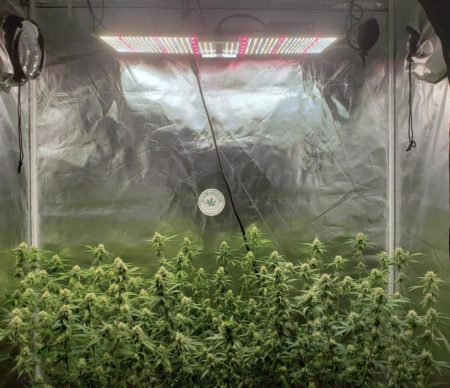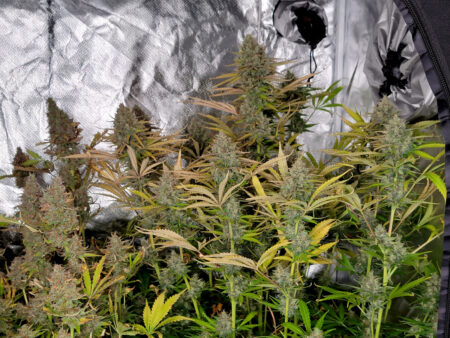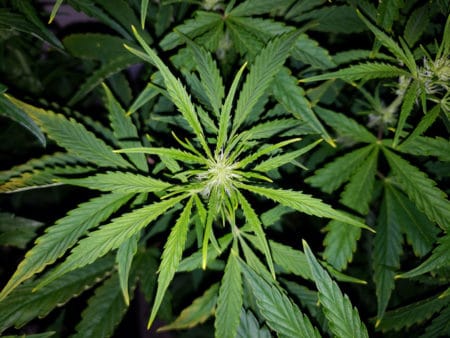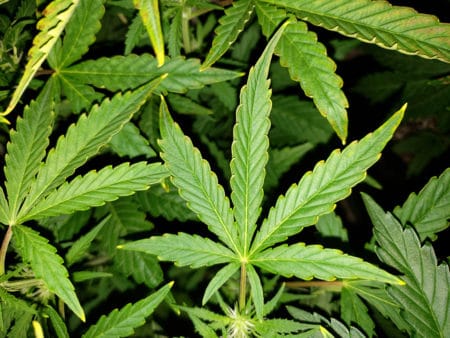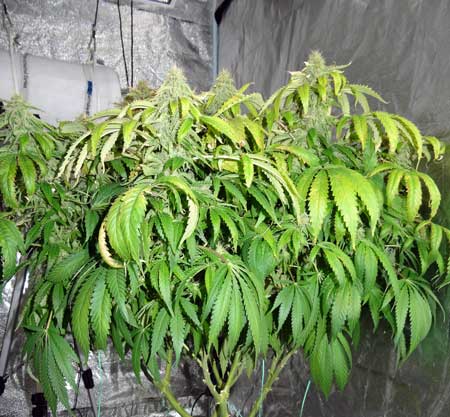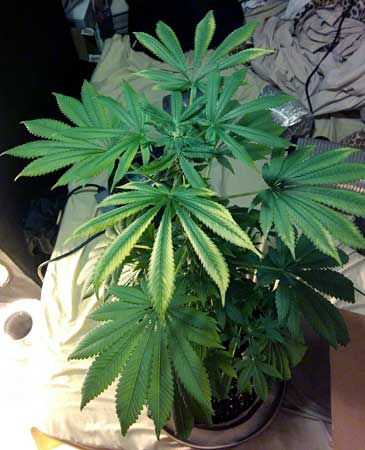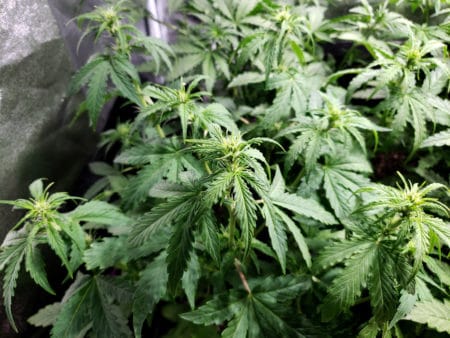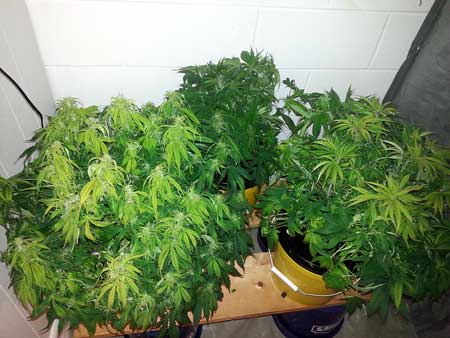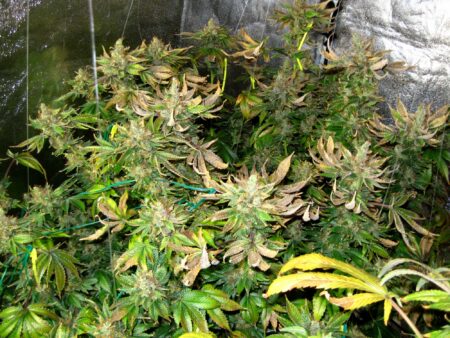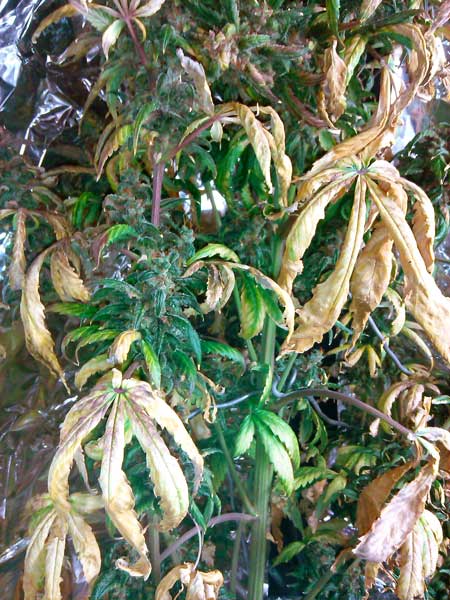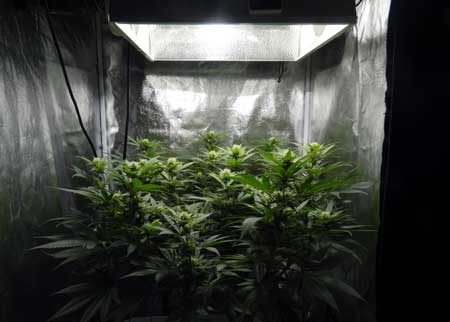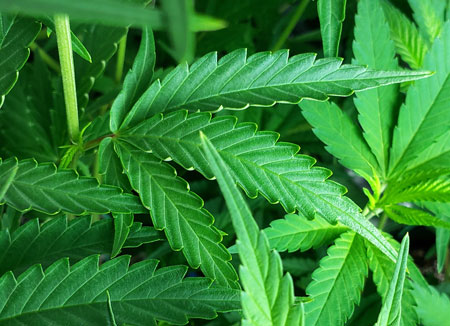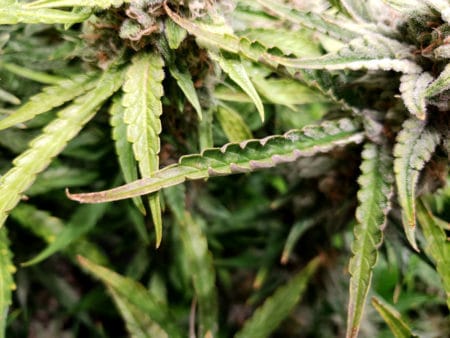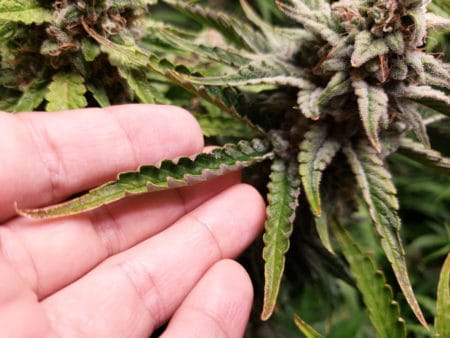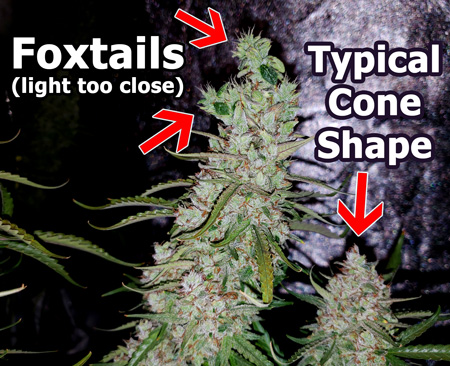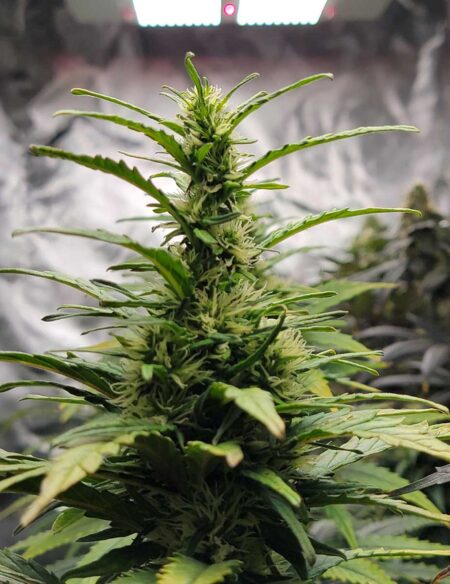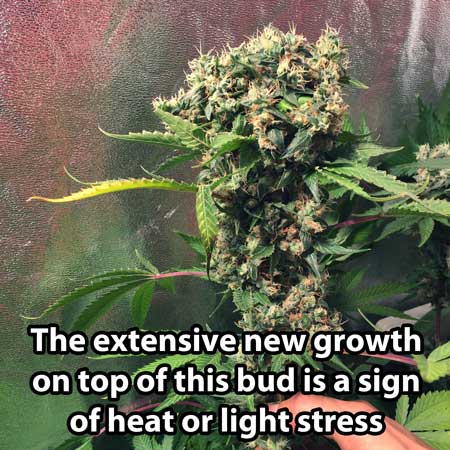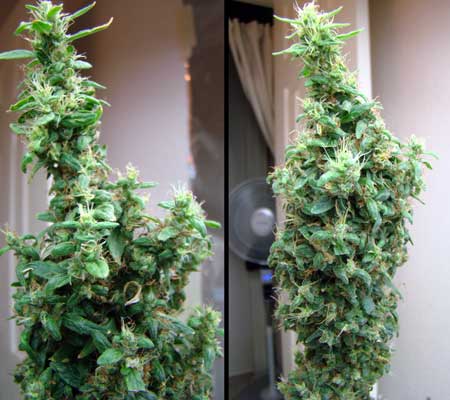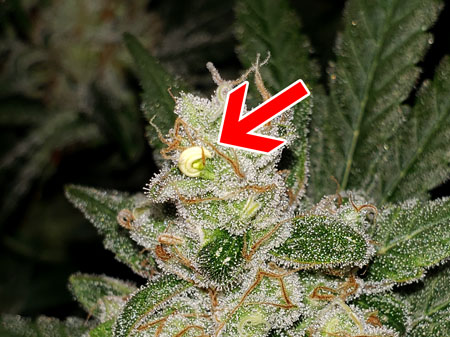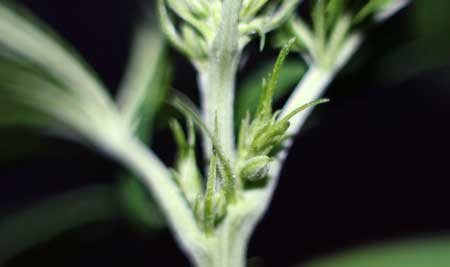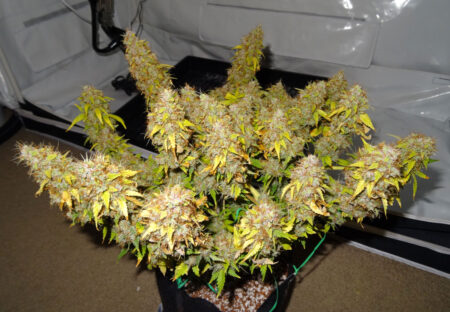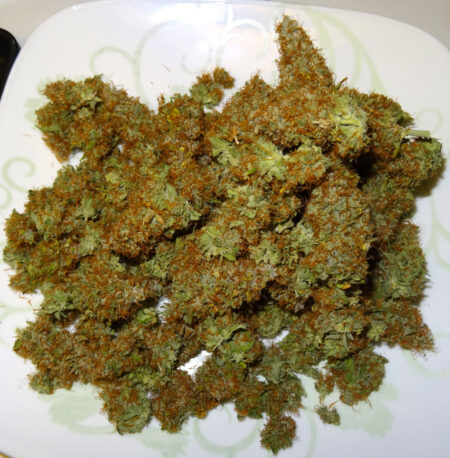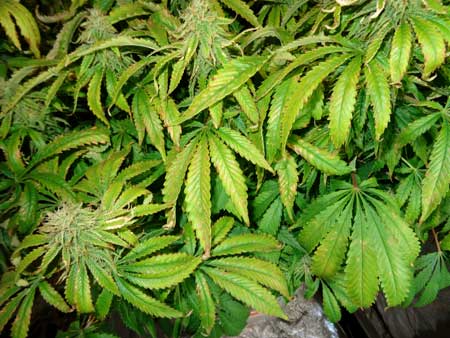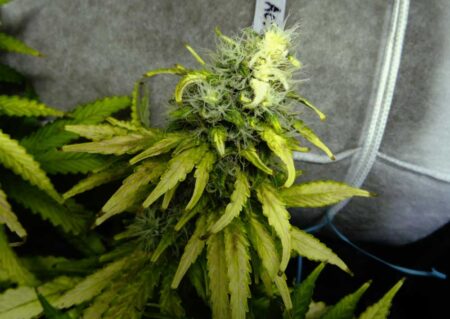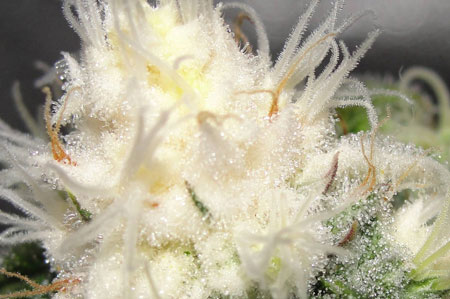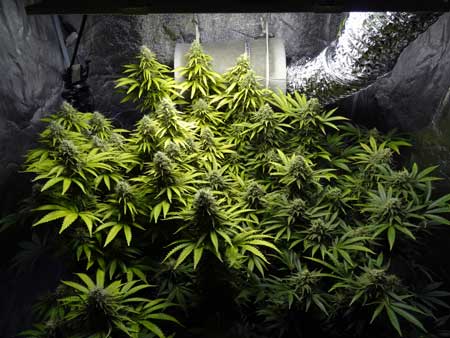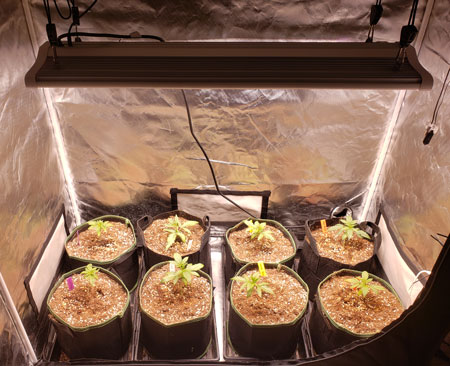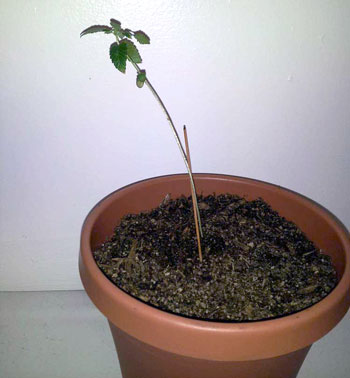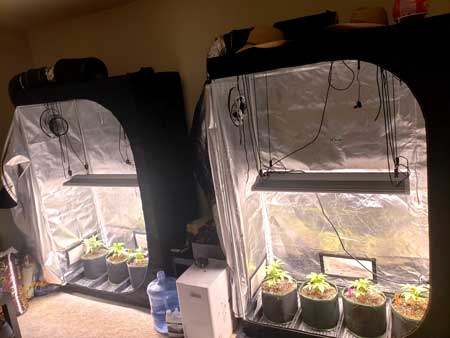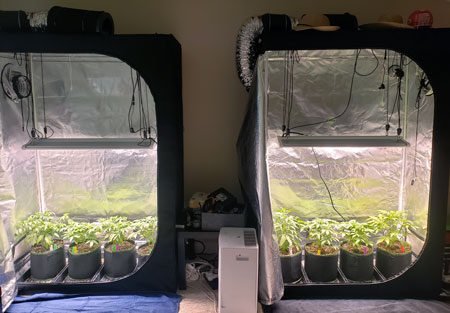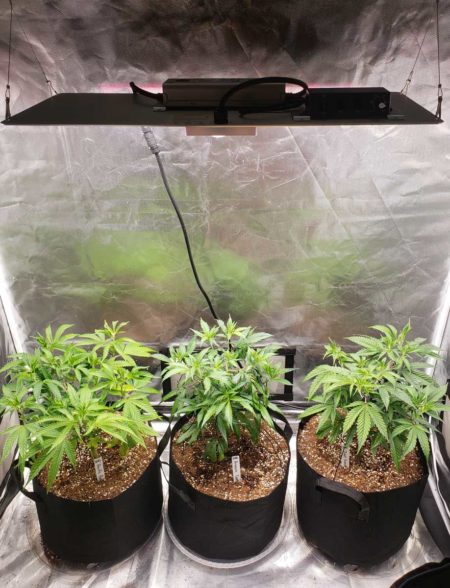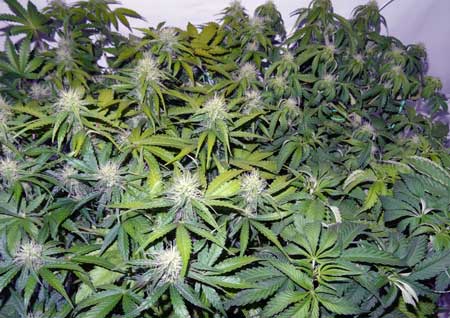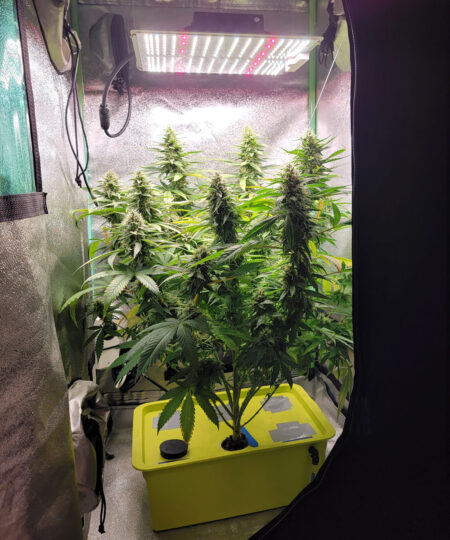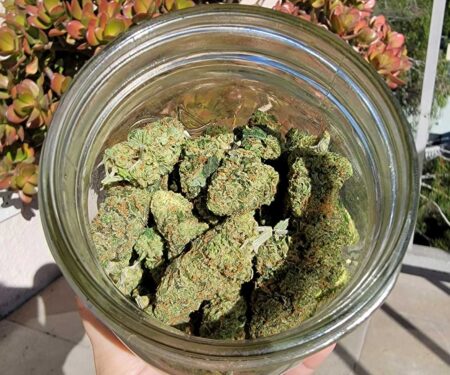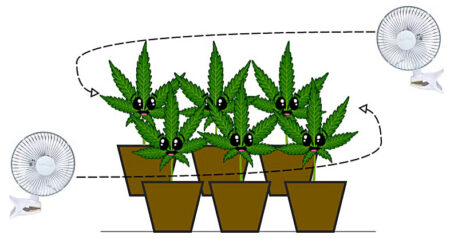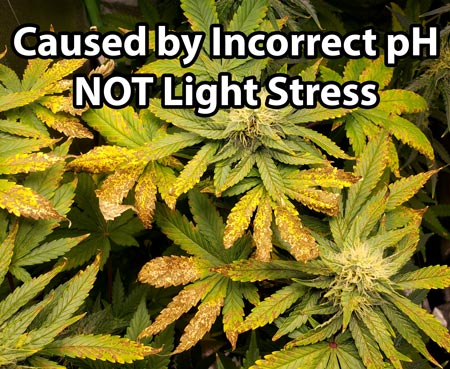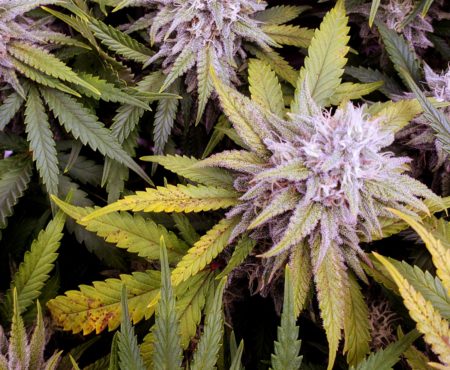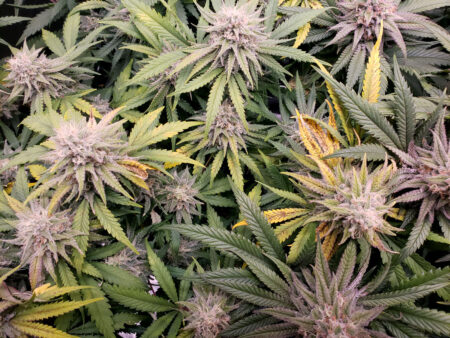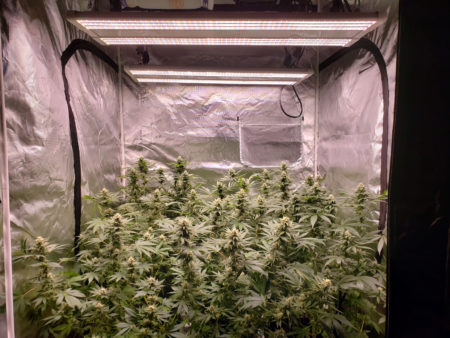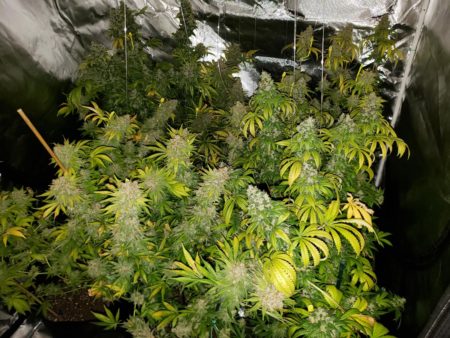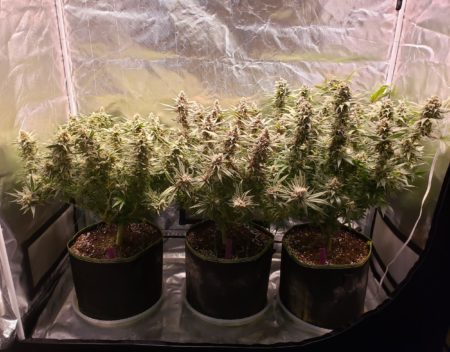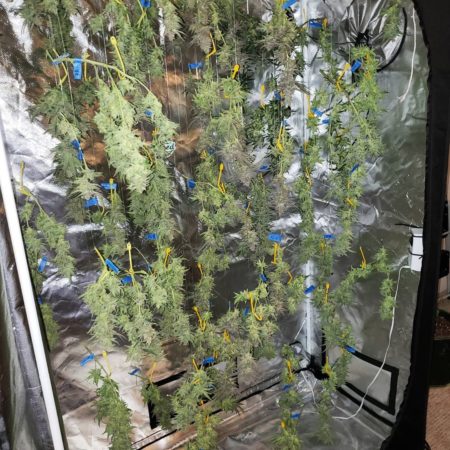by Nebula Haze
“Am I giving too much light or not enough?” “How far do I keep my LEDs from my plants?” “Is it light stress or a cannabis nutrient deficiency?” These are important questions and today’s LED grow light tutorial will answer them all. No more mystery.
Is this LED too close or too far from the cannabis plants? Learn how to tell the difference for your LED grow light!
Learn what light stress is, how to tell whether your LED grow lights are too close or too far from your cannabis plants, and what to do if you see symptoms on the leaves. Finally, I’ll share my proven strategy to keep your LED grow lights the right distance from your marijuana plants from seedling to harvest, so you maximize growth and yields. If you’re growing weed under LED grow lights, you can’t miss today’s tutorial!
Avoid Light Stress by Keeping LEDs the Right Distance Away
Keep your LED grow light the perfect distance away from cannabis plants to maximize plant growth, yields, and bud quality. But how do you know the best distance?
Recommendation: Follow the manufacturer’s recommended distance or contact the LED company directly for guidance. I’ve been pleasantly surprised to find that most LED companies answer questions about how to best use their LED grow light. If you still can’t find any information about your specific LED model, here’s a set of basic guidelines to follow.
- Small LEDs around 100-200W are usually kept about 12-18″ away.
- Medium LEDs like 200-300W are usually kept about 18-24″ away.
- Big LEDs from 300-600W are usually kept about 24″ or more away.
These are good general rules, but even more important is to pay attention to your cannabis plants and see what they “tell” you.
In the next section, you’ll learn how to tell whether your LED grow lights are too close or too far away from your cannabis based on how the plants look. Light stress can affect the leaves as well as the buds, though the symptoms are a bit different. Here’s a picture guide to cannabis light stress symptoms in leaves, followed by a guide of what light stressed buds look like.
Avoid stressing your cannabis plants with too-close LEDs!
If you see symptoms of light stress, move your grow lights further away until the symptoms stop spreading, then slowly start to move it closer again.
Now, here’s what to look for…
Light Stress Leaf Symptoms (LEDs are Too Close)
Here are common light stress symptoms in cannabis leaves, with pictures.
- Yellow leaves or leaf tips – Pale or bleached leaves are the most common light stress symptoms, often mistaken for a nitrogen deficiency or other nutrient deficiency. Sometimes only the tips of the leaves turn yellow at first. Not to be confused with nutrient burn, which causes brown leaf tips.
- Droopy top leaves – Sometimes the leaves are droopy, like they’re working too hard and just got tired.
- Scorched leaves – Leaves that get extreme light levels may turn brown, scorched, and “burnt” or withered, like they went through a crazy heat wave.
Yellow leaf tips appear in many cannabis strains in response to light stress. If the LED grow light isn’t moved further away, the symptoms may start spreading to the whole leaf.
In addition to the yellow tips on leaves, the leaves may have an overall dry or stressed appearance.
Yellow leaves from light stress. The top leaves on this cannabis plant are turning yellow due to a too-close light. However, the leaves that are further from the grow light are still a healthier green.
This cannabis plant started showing light stress symptoms on just a few leaves at first. If you see stress at the top of the plant, move the LEDs further away.
Droopy top leaves from light stress. Some cannabis strains respond to light stress with droopy leaves. If moving the LED grow lights up causes the leaves to perk up, that’s a sign it was too close.
The top leaves of these cannabis plants are both bleached and droopy due to the LED grow light being too close.
Scorched leaves from light stress. These leaves look like they were burnt in the sun. The cause was a too-close grow light. In this case, there was a mix of heat and intense light levels.
These cannabis leaves turned yellow and wilted from being too close to the LED grow light. In this case, the grow room was the perfect temperature. Light stress can attack even when it isn’t hot!
First Signs of Light Stress
These symptoms are often some of the first signs of light stress. Neither of these will cause damage to the leaves or plants, but they’re a sign your plant is working hard and that you should keep a close eye on its health.
Extra perky top leaves are sometimes called “praying” leaves. These leaves are pointed up a bit, which happens when they’re working hard. This is a good thing as long as the leaves stay green and healthy, but since the plant is “on the edge” of too much light, make sure watch out for signs of actual light stress damage such as yellowing, burnt marks, fox tails, herms, etc.
No damage yet, but keep a close eye on hard-working leaves.
Upturned leaf edges from light stress. This is a symptom that your plant is reaching the maximum amount of light it can process in a day. More common with watering problems and cool night temperatures. Watch closely as this may start to develop into leaf damage if the conditions don’t improve.
If you don’t move the LED grow light further away, the symptoms may start leaving damage and become permanent.
Light-damaged leaves feel crispy. Pieces of leaf may easily break off.
Cannabis Bud Symptoms When LEDs are Too Close
Here are common symptoms you may see on cannabis buds that get too much light.
- “Fox tails” on buds – These funny-looking growths appear on cannabis buds that are too close to the grow light. Learn about cannabis foxtailing.
- Bananas or Pollen Sacs – Too much light on buds can cause the plant to “herm”, or grow male flowers. Buds start growing little yellow growths, or you may see green balls appear where buds should be. Watch out because this can cause seedy buds. Learn about herming.
- Bud discoloration – Just like the leaves, cannabis buds can get yellow, brown marks, or bronze splotches from the LED grow light being too close. Typically the symptoms start on the leaves first, and only spread to the buds if the lights aren’t moved further away.
- Loose buds – When the LED grow light is too close, buds may grow loose or airy, and not get dense as harvest time approaches.
- Bleaching (“albino buds”) – Buds that area too close to the LED grow light may get bleached yellow or even pure white in rare instances.
- Prone to problems – Buds that are experiencing light stress from too-close LED grow lights tend to be more prone to all kinds of issues including white powdery mold, bud rot, and certain bugs like spider mites.
- Low Potency or Smell – The worst symptom of buds that developed with the LED grow light too close, is the buds may end up with relatively low THC levels or terpene levels.
Keeping LEDs the right distance away maximizes bud quality in many ways!
“Fox tails” on buds from a too-close LED grow light. If you see foxtailing on your buds, reduce the light levels in one of three ways: bend your cannabis buds so they’re further from the light, move your LED grow light up, or turn down the power so it isn’t at full light intensity.
The top part of this cannabis bud is growing long and thin because it is “foxtailing” as a result of the LED grow light being too close.
Here’s an example of foxtailing that got out of control.
The strange shape of these cannabis buds is due to extensive foxtailing from the LED grow light being kept too close.
Bananas or Pollen Sacs are unwanted growths where buds should be growing. These can sometimes be triggered by light stress, especially in strain that are prone. If you see any bananas or pollen sacs, you should remove the plant immediately or it may release pollen and cause all the buds in the grow space to get seedy. Learn more about bananas and pollen sacs.
Example of a hermie banana on a cannabis bud, caused by light stress.
Example of pollen sacs growing where buds should be. Don’t ignore!
Bud discoloration can cause buds to get yellow leaves or brown markings. Usually discoloration affects fan leaves first, then only spreads to the buds if the leaves have been suffering from light stress for a while.
The light-burned cannabis buds from the above plant are still smokeable, but they aren’t as pretty as they could be.
Loose buds are common on light-stressed plants. For example, none of the buds on this cannabis plant are getting fat or dense. They’re all growing with a light, airy bud structure as a result of stress.
Bleaching can cause “albino buds” and bleached leaves on the parts of the plant closest to the LED grow light.
The leaves and parts of the cannabis bud are completely bleached.
Light-bleached cannabis buds may turn pure white. This is the result of the grow light being too close.
Example of widespread cannabis light stress: You can see the leaves closest to the grow light have all turned yellow. The lower leaves are still green.
Is my LED Grow Light Too Close or Too Far?
Ok, now that you know what light stress looks like, let’s get to the practical step of figuring out how far to keep your LED grow light, and when to adjust it.
My Proven Strategy for the Right LED Intensity and Distance
Seedlings – 2x distance, 50% power
First, when it comes to seedlings and young cannabis plants, start LEDs at twice the recommended distance away, and turn the light down to 50%. Thes ensures you don’t give too much light when seedlings are still too young to use it.
This LED is recommended to be kept 18-24″ away. So for seedlings, I start them at 36-48″ away at 50% power.
If seedlings start getting too tall without growing leaves, it means they want more light. Otherwise leave them alone to start growing up to the light.
Move LED grow light closer if seedlings look “leggy” with a lot of stem. This is a sign they need more light.
Week 2 – Raise power to 75%
When seedlings are about 2 weeks old, as long as they’re growing fast and healthy, raise the power of your LED grow light to 75% power.
Week 3 – High end of recommended vegetative distance.
Around week 3, try to get to the high end of the recommended distance. So if the recommended vegetative distance is 18-24″, then try to get your light to about 24″ away. Of course, only move your LED grow light closer if cannabis plants look healthy and happy.
Week 4+ of Vegetative Stage – Keep recommended distance away (high end) at 100% power.
After plants are 4 weeks old, you might consider upping your LED grow light to 100% light intensity. Only do this if the plants look totally green and happy. Otherwise, it’s okay to keep the LED at 75% throughout the vegetative stage.
This Spider Farmer SF-2000 LED (200W) was kept 24″ away at 100% power and plants thrived.
What to do if you see symptoms of Light Stress
- Move your LED grow light further away and fix any other problems with the environment.
It takes about an entire week for the plant to recover completely, or more. If you’ve fried some leaves, you’ll have to wait for a whole new set of leaves to appear from the plant before you can consider it healthy again. Be patient for this process to happen before jumping into the flowering stage, if possible.
Flowering Stage LED guidelines
In general, the closest your LED grow light should be to your cannabis plants is 100% intensity at the closest recommended range. So if the manufacturer says to keep the light 18-24″ away, in general you shouldn’t move the LED closer than 18″ away. If you’ve got great conditions, your plants may be able to handle more light, but it also greatly increases the chance of them getting stressed out.
- React quickly to light stress – If you see signs of light stress, move the LED grow light further away right away. Don’t wait.
- Only move light closer to healthy green plants – Wait until you see new healthy green leaves before moving your LED grow light any closer.
- Keep a good temperature – Avoid letting it get hot (above 80°F) or cold (below 65°F) in the flowering stage, as light stress is more common with temperature fluctuations.
- Good airflow – There should be a gentle breeze in the grow space, and plenty of fresh air.
- Avoid nutrient deficiencies – Make sure to maintain the right pH at the roots and give good nutrients to avoid deficiencies. Often what seems like light stress is actually the result of a nutrient deficiency caused by too high or too low pH.
- LEDs perform well from afar – It’s true that you maximize cannabis yields by keeping your LED grow lights as close as possible without stressing out your cannabis plants. However, modern LEDs are extremely well-suited to growing cannabis plants, and can produce surprisingly good yields even if you keep them much further than the recommended distance.
Flowering cannabis plants can handle more intense light than they did as young plants, but only if they’re kept healthy (not nutrient deficiencies) and in a good environment (not too hot, not too cold).
React quickly to light stress by moving LEDs further away from the tops of plants, or turning down the intensity to 50 or 75%.
If you see yellow leaves from light stress (only the leaves closest to the LED grow light are turning pale), don’t ignore the problem or your buds may not develop properly!
Only move light closer to healthy green plants. This LED grow light is closer than the recommended distance away, but the leaves are all completely green and healthy. When you take amazing care of a plant, you can often move the LEDs closer than expected. But it’s better to have a healthy plant that close lights.
Keep a good temperature above 65°F and below 80°F in the flowering stage if possible. This not only reduces the chance of symptoms from light stress, but also buds grown in the right temperature tend to develop tighter and denser with maximum potency. Learn more about how the environment affects bud quality.
Maintaining the right temperature while buds form not only prevents light stress but also makes buds grow with more dense bud structure.
Good airflow with a gentle breeze and plenty of fresh air helps prevent light stress, and improves bud development.
Don’t ignore nutrient deficiencies. Often your “light stress” is actually the result of a cannabis nutrient deficiency from the pH being too high or too low at the root zone. See what leaf symptoms are caused by PH problems or check out our free plant doctor tool to diagnose your sick cannabis plants.
These brown marks or splotches may be mistaken for light stress, when the real issue is the pH at the roots is too low.
Another example of “light stress” being caused by low pH at the roots.
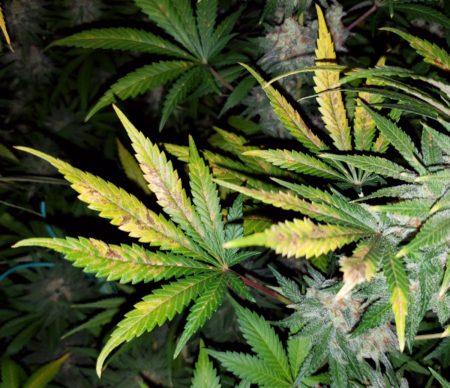
Note: Even when the true cause of the problem is incorrect pH, it’s still a good idea to move your LED grow light further away until you’ve fixed the pH and the symptoms stop spreading.
Modern LEDs are powerful even at a distance. This is 600W LEDs, which were kept 3 feet (~1 m) away from plants and produced excellent yields in a 4’x4’x6.5′ grow tent with “just add water” super soil. Many LEDs can be kept quite far from plants and still produce a good harvest.
Don’t be too hard on yourself if you see light stress on your plants. It happens to every grower, especially when using a new LED grow light for the first time. Every new LED grow light seems to be more powerful than the last!
If your cannabis plants get light stress, it doesn’t mean to throw away your harvest! Even if light-stressed buds aren’t pretty, they are usually still good to smoke!
Key Takeaways
With modern LED grow lights, cannabis plants can still grow well and produce excellent buds even if the LEDs are “too far” away. If your plants look stressed, try raising the light or dimming it down to 75%. It’s better to have healthy plants than maximum light levels, because healthy cannabis plants produce better bud quality than highly stressed plants. If you stress your plants too much with light, it can even end up lowering your yields overall.
Remember, you can keep the LED light a bit closer or brighter next grow.
What next? Check out my favorite LED grow lights for growing cannabis.

